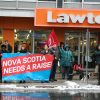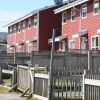This article was originally written for RankdandFile.ca – Canadian Labour news and analysis from a critical perspective
KJIPUKTUK (Halifax) – Something very much out of the ordinary is happening in Newfoundland and Labrador. People are so angry about the recent provincial austerity budget that even long-time activists say they have never seen the likes of it.
The newly elected Liberal government, facing huge drops in oil revenues, cut public services, jobs, and grants to community groups, closed public libraries and raised taxes and fees. Even books will be taxed. There is also the so-called temporary deficit reduction levy, a regressive tax that hits low and medium income people much harder than the rich.
It’s not just the usual suspects who are upset this time. Across the island and the vast expanse of Labrador people are making their voices heard.
Anger at both parties
“I am just a regular schmuck, and I organized one of the protests that happened here in Stephenville,” Shane Snook tells Rankandfile.ca. “There are totally ordinary Joe Blows like myself across the province that are making these rallies happen, getting petitions signed, you name it.”
“What gets people upset is the arrogance of the politicians,”” says Snook. “People are saying loud and clear that they don’t want this budget, and the Liberals respond saying that’s too bad, but we know better than you.”
The anger is not just directed at the Liberals. The Conservative opposition, in power until late last year and responsible for much of the mess, is not gaining much of an advantage from the protests.
“For the first time in my lifetime the general public is wise to both the Conservatives and the Liberals at the same time. For once we’re angry at both parties,” says Snook.
Intense pushback
Jerry Earle, president of the Newfoundland and Labrador Association of Public and Private Employees (NAPE) has been active in the labour movement for a long time. The intensity of the current protests took him by surprise.
“You can always expect pushback from labour organizations, but we are seeing students, we see new groups being created , seniors, women’s groups, community activists, municipal leaders, I see people attending union rallies that I would never have dreamt of seeing.”“I attended my first union meeting way back in 1981, I’ve been around for Clyde Wells, Danny Williams, Brian Tobin, but I have never seen a movement anything like today’s,” says Earle.
Taking a stand
Lana Payne, Atlantic director of Unifor, agrees. The protests are spontaneous, grassroots and deep, she says. As to why this is so, she points to broken Liberal election promises, the severity of the cuts as exemplified by the widely reported library closures, and the regressive nature of the deficit levy.
Further adding to the Liberals’ problems is the vocal opposition to the tax on books by a much-loved Newfoundland arts community, Payne says.
“We’re seeing spontaneous rallies in dozens of rural communities, and they are being organized out of the blue, not by any organization, not by labour, often it’s just somebody in the community who feels that she needs to take a stand, that this budget is wrong,” says Payne.
Of course no protest is ever entirely spontaneous. Across the province groups and coalitions are forming in order to organize protests. Some of them have a strong labour presence, others not so much.
Justin Brake, editor of the thriving progressive news site The Independent, describes how the two streams align. Earlier in May, Brake attended a huge rally on Confederation Hill in St. John’s.
“That rally was initially organized by the Newfoundland and Labrador Federation of Labour (NLFL), but then all these other marches started happening, some labour, some not, and they all converged at Confederation Hill,” says Brake.
“There are separate streams involved in the protests, the grassroots coalitions are definitely identifying as being separate from the unions, but they are going out of their way to show solidarity, which is why they marched to the union rally,” Brake explains.
Mary Shortall, president of the NLFL, spoke at that rally on Confederation Hill. Her organization is a prominent member of theCommon Front NL, created to coordinate some of the anti-austerity activities. Unions are well represented, but the Federation of Students, the Council of Canadians, the Social Justice Cooperative, and many others, are also participating.
Coordinated or spontaneous, it’s all good, says Shortall. “Some actions we cannot formally endorse, but it’s really good that those things are happening independent from us.”
Independence brings its own legitimacy, she adds. She mentions Adam Pitcher, an activist who brought out 700 protesters for one event in St John’s, without any base to pull from. “To me that’s almost more powerful than when we organize a rally and get 3000,” she says.
Nobody is giving up
So will the protests continue to gain strength, or will it be just another flash in the pan?
There are a couple of reasons to believe this one isn’t going away any time soon.
Shortall observes that this time the public is remarkably well-informed about the true nature of austerity budgets, and she believes a labour campaign that was initiated months before the budget was revealed can take some credit for that.
“Nobody is giving up. We have a history of government saying this is good for you, so shut up and put up. This time people are saying we are not shutting up,” she says.“There is a real discussion about fair taxation, about progressive tax regimes. The public seems mature, they speak with their heart, but they understand that austerity budgets don’t work,” says Shortall.
Even if protests die down in the summer, they are bound to pick up again in the fall, courtesy of the Liberal government who announced an interim budget at that time, expected to contain more cuts, privatization of public services, and layoffs.
Piled high with difficulty
It’s a mess of the Liberals own making, says Payne. What is lacking is a plan with vision.
“The problem is that all we’re seeing is slashing and gutting of programs and services, and nothing on how to grow and diversify the economy,” says Payne. “Had there been a bit more of that, people would not have been happy, but you would not have seen the outrage we are seeing.”
The Liberal government projects that unemployment, already Canada’s highest at 13 percent, will rise to 20 percent by 2021. Real wages will be lower than current levels by 22 percent at that time. Even the provincial government admits that the austerity budget will account for 40 to 50 percent of these predicted declines.
“People in Newfoundland and Labrador understand the occasion is piled high with difficulty. We believe there is another path forward. We have some opportunities here,” says Payne, who mentions the province’s skilled and agile workforce, value-add opportunities in the natural resources sector, and the need to explore green jobs.
“Without a vision and a plan we will make the mistakes of the past, the very hard-nosed decisions to eliminate the deficit that actually make the problem much worse. I can see that happening again, we need to be careful that we don’t cause a heck of a lot of damage to the economy,” says Payne.



